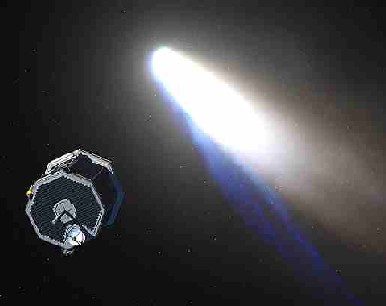Click on image for full size
Courtesy of NASA
CONTOUR Lost in Space
News story originally written on August 27, 2002
We are sad to report that the Comet Nucleus Tour (CONTOUR), which launched July 3, 2002, is currently lost in space. The CONTOUR spacecraft was to explore the nucleus of comets. It was scheduled to fly by at least two comets over the next few years, taking pictures and collecting dust from the nucleus of each.
On Aug. 15, 2002 CONTOUR's rocket ignited to boost the spacecraft out of Earth's orbit. At that time, it was about 140 miles above the Indian Ocean and out of radio contact with controllers, but they expected to regain contact within an hour. Since the rockets ignited, there has been no contact with CONTOUR.
The team that created CONTOUR had pre-programmed the spacecraft's computer to try many different ways of contacting Earth in the event that contact was somehow lost. None of these extra ways of contacting Earth seem to have worked because there has still been no communication with the lost spacecraft.
Pictures from the telescope at Kitt Peak, Arizona show three objects at the location where CONTOUR should be. Since CONTOUR was originally in one piece, these pictures may indicate that the spacecraft has broken apart.
Mission controllers have not given up hope! There is a possibility that the main part of the spacecraft is still intact if two non-essential parts came off. They will continue listening for signals from the spacecraft until early December, when CONTOUR will be in a better location to receive a signal from Earth.















